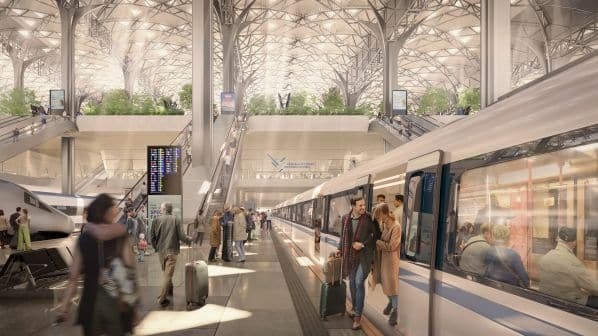WORK has begun on the biggest transport infrastructure project in Poland: the Central Communication Port (CPK), which will see the construction of a new airport, 12 new high-speed rail lines totalling 2000km, and the modernisation of 3700km of railway. Together, the project will reduce travel times across the country, allowing passengers to travel from Poland’s largest cities to the new airport between Warsaw and Łódź in less than 2h 30min.
Feasibility studies are now underway or completed for 1500km of the new network, with the final “investor variant” presented for five sections totalling more than 600km. The first step in construction is the start of tunnelling in Łódź for the Warsaw - Łódź line, which is due to begin in the late autumn.
The “heart” of the new CPK network is the multi-modal transport hub between Warsaw and Łódź, which will include the airport’s terminal, railway station, Public Transport Interchange (PTI) including a bus station, taxi rank and car park all strategically located in close proximity to achieve the integration of these different modes of transport. These will be connected by a central covered atrium. An area has also been reserved for a “vertiport,” to enable unmanned aerial vehicles to operate from the airport in future.
CPK in August unveiled the airport’s concept design, developed by a consortium of Foster+Partners and Buro Happold. The airport will initially have two 3.8km-long runways, with space reserved for a third.
The underground station will have six island platforms for long-distance, regional and commuter rail services. As well as providing access to the airport, the station will itself be a major rail transfer hub, providing connections between a number of lines including:
- LK1, LK4 towards Kraków and Katowice, and locally towards Grodzisk Mazowiecki and Żyrardów
- LK3 towards Sochaczew and Błonie
- LK5 towards Płock and Tricity (Gdańsk, Sopot and Gdynia)
- LK85/LK86 towards Warsaw, Łódź, Wrocław and Poznań, and
- LK58 towards Rzeszów.
In the longer term, the Warsaw Commuter Rail (WKD) line from Grodzisk Mazowiecki may also be extended to the CPK terminal.
“I think the main advantage of having air and rail under one umbrella is being able to elevate the standard of service from what we may typically see at the railway station to what we may see at the airport,” says CPK CEO, Mr Mikołaj Wild. “Everything which provides us with a seamless journey, diminishing the stress and improving transfers. [It’s about] bringing a new standard of service to railway passengers.”
Two additional stations will be built within the airport complex for regional rail services. The CPK East station will provide access to the Airport City, a new development featuring hotels, offices, conference and administrative facilities to the east of the terminal.
The CPK West station will serve the freight terminal on the western side of the airport that will be rail-connected, with forecasts indicating the new airport could increase air freight from 100,000 tonnes pre-Covid to around 1 million tonnes as early as 2035.
The hub will be connected to 10 high-speed rail spokes radiating across Poland which, along with the remaining two high-speed lines and major upgrade works, will significantly improve access to rail around the country.
Funding for the rail investment is split across three sources: the Polish government, grants from the European Union, and public-private partnerships (PPP) with the general constructors. Under the PPPs, the contractor will partly fund the construction element of the project itself but will also be awarded a long-term maintenance contract that will include repayment for the capital costs.
“The cost of construction is split over the next few decades,” Wild says. While he was unable to give an up-to-date cost figure for the rail element for the project, he says it is currently in the order of “10s of billions of euros.”
CPK has opted for a two-stage tendering process to select the contractors for this mammoth project. Under the first stage of the tendering process, companies are judged solely on their capability to undertake the work required. The selected companies are then invited to bid for the individual contracts, with these bids then judged mainly on price.
For example, in July 2022 CPK selected 11 consortia, which brought together 27 companies from Poland, Spain, France, Germany and Korea, for an eight-year framework contract worth Zlotys 7bn ($US 1.49bn) to undertake design work for the new railways. These consortia were then invited to bid for the design contracts for the individual lines under the second stage of the tender process.
Wild says there are multiple benefits to using the two-stage approach. For one, he says the process is faster, as the first stage can be carried out while the terms of the tender for the second stage are still being defined. The process also builds trust between CPK and the supplier, Wild says, and allows CPK to fully assess the contractor’s capabilities based on previous projects they have undertaken.
When work first began on the project, CPK was unique in the market in requiring the full project to be built using Building Information Modelling (BIM). BIM creates a complete digital model of the new infrastructure for both construction and subsequent maintenance. This was initially challenging for the project’s suppliers, who may not have had the full skills and experience to use BIM, but that has since changed and BIM has become the industry norm.
“At the beginning it was kind of a challenge for the market but now we have seen that it has become a standard and the market is ready to work with us in this BIM environment, which is good both for investor and the contractors,” Wild says.
Operating model
While its main focus at the moment is the construction of the rail network and the airport, along with the upgrade of the existing network, CPK is not just responsible for the infrastructure. “Our competence is not just focused on the infrastructure, our responsibility is to provide a new transport system for Poland, in which rail is of course the most crucial part,” he says.
As part of this broader role, CPK has developed a number of advanced forecasting and planning tools to advise the government on which lines should be prioritised.
The first of these is the creation of a Passenger Transport Model (PMT), which Wild says is in CPK’s opinion the “most modern, advanced forecasting tool” available to predict future passenger flows. This has allowed CPK to project how each stage of development will impact passenger flows, where demand is expected to be highest, and also how carrying freight on the new lines could impact capacity.
“The high-speed line is not designed for freight but to a certain extent it will be possible to carry light cargo on the new lines and we are able to forecast that,” Wild says.
The model was built using the PTV Visum simulation software package, and compares different modes of transport such as rail, road and air to provide an analysis of the competitiveness of each mode. CPK has also made the model available to interested stakeholders such as local government, public transport operators, and consulting and design companies to harmonise planning activities.
Using the forecasting model, CPK predicts that nearly 134 million passengers are expected to use long-distance rail in Poland when the network is completed, including 108 million passengers on inter-city trains and 26 million on regional express trains, compared with the 49 million passengers who used PKP Intercity services in 2019.
The route between Warsaw and the CPK airport is expected to carry up to 65,000 passengers a day, as up to 40% of people using the airport are expected to arrive or depart by rail. Around 50% will use cars and taxis, while the remainder will use buses and other modes of transport.
The second tool is a “horizontal time schedule” which has been used to assess the most efficient way to create a rail offer for passengers travelling between particular cities.
“If we can’t take advantage of this unique situation, it means that new means of transport could create a great risk for railway expansion in the future.”
Mikołaj Wild, CPK CEO
Using these tools, CPK has developed a multi-stage development plan for the construction of the new lines. However, Wild says this plan is also not necessarily based on the potential for economic growth, but also includes a focus on connecting areas that have historically been underserved by rail.
“Our ambition is not only to connect the biggest cities of Poland, which of course is where you may see the easy economic benefits, but to also eliminate the transport exclusion of certain parts,” Wild says. “We are building some lines which may not have as much demand, but they are needed because we eliminate social exclusion through them. Taking into consideration the needs of people living in the smaller cities is also our priority.”

In addition to its infrastructure-based roles, CPK is also likely to be responsible for purchasing high-speed rolling stock, with an estimated 150 trains needed to operate the new network. This responsibility is included in a new government programme currently being scrutinised by the Polish cabinet.
Wild says the trains would be purchased by CPK and leased to potential operators, in an effort to lower the threshold to entering the market, including for private operators.
“In 2030, the new railway package will go into force in Poland so the network needs to be fully open-access,” Wild says. “Our goal is to provide as big a modal share for rail as possible. We see the experience of other countries like Italy or Spain where the liberalisation [of the market] means more passengers, more competition and the best offer for the passenger, so we are interested in that.”
External connections
As well as transforming travel within Poland, the network could also play a major role in connecting high-speed rail across Europe due to Poland’s central location.
In January, CPK signed a memorandum of understanding (MoU) with RB Rail, the body overseeing the Rail Baltica project, and Czech infrastructure manager SŽ, to strengthen cooperation on the development of high-speed rail in northeast Europe.
The agreement, signed during the Railway Direction Days 2023 conference in Warsaw on January 18, builds on a cooperation agreement signed by RB Rail and CPK in June 2022. During the conference, CPK also signed a cooperation agreement with Ukrainian Railways (UZ) that covers the preparation of a feasibility study for new 1435mm-gauge connections between Poland and Ukraine, including a Warsaw - Lviv - Kyiv high-speed line.
But while these agreements strengthen the connections to the east, Wild says is has been more difficult to build connections west into Germany. Expansion of the German high-speed network eastwards towards Poland was halted some years ago, and there has been no indication that this will be revived.
“I spoke this year with our colleagues from DB Network and for some reason they do not plan railway expansion, especially high-speed railway expansion, eastwards,” Wild says. “So in order to efficiently spend our money, for the time being we have not planned to connect our western parts with the eastern parts of Germany.”
However, he says Poland is willing and ready to begin development if Germany did announce a change in strategy. “Germany is our biggest economic partner in terms of the trade exchange so it would be efficient for both sides,” he says.
Ultimately, Wild says, the timing couldn’t be better for the expansion of rail due to the need for carbon-neutral forms of transport capable of moving large flows of passengers and freight, but this makes it all the more important to capitalise on this as a matter of urgency.
“It might be the last chance for the railway,” he says. “If we can’t take advantage of this unique situation, it means that new means of transport could create a great risk for railway expansion in the future.”

